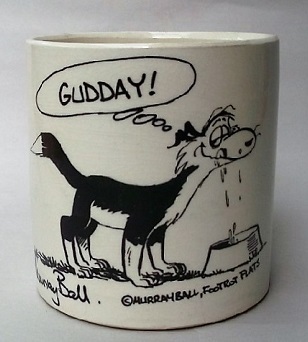Latest topics
McSkimmimng Hoffman Kiln
4 posters
NEW ZEALAND POTTERY :: New Zealand Commercial Potteries :: More New Zealand Commercial Potteries :: Benhar / McSkimmings Pottery
Page 1 of 1
 re McSkimmimng Hoffman Kiln
re McSkimmimng Hoffman Kiln
Thanks mrmarna,
Knew Benhar , used to stay at Balclutha and Paratai Kaka Point in my youth with Gran. and relations.
If you go to Bricks on the forum and click on James Shears you will see another Hoffman
Kiln this time a round one. They were the more common type apparently.
Curiously according to Monk {Page 15} a Fred Hoffman worked at Crown Lynn and was known as "The King of the Kilns"
regards,
jonno
Knew Benhar , used to stay at Balclutha and Paratai Kaka Point in my youth with Gran. and relations.
If you go to Bricks on the forum and click on James Shears you will see another Hoffman
Kiln this time a round one. They were the more common type apparently.
Curiously according to Monk {Page 15} a Fred Hoffman worked at Crown Lynn and was known as "The King of the Kilns"
regards,
jonno

Jonno- Number of posts : 662
Location : Milford,Auckland
Registration date : 2011-05-13
 Re: McSkimmimng Hoffman Kiln
Re: McSkimmimng Hoffman Kiln
im gonna go there and just take heaps of pics of it, its just too gorgeous.
 some of my pics
some of my pics
excuse the crappy pix these were taken with my cellphone
[You must be registered and logged in to see this image.]
[You must be registered and logged in to see this image.]
 Re: McSkimmimng Hoffman Kiln
Re: McSkimmimng Hoffman Kiln
Those pics are excellent narna .... your cellphone does a good job!!
Excuse me but those archways remind me of firing chambers ...... ?
They can't be surely! So what are the chambers for???
Excuse me but those archways remind me of firing chambers ...... ?
They can't be surely! So what are the chambers for???
 re McSkimmimng Hoffman Kiln
re McSkimmimng Hoffman Kiln
Hi Ev,
The chambers are where the green bricks were loaded and then the opening is bricked up until ready for unloading the fired bricks. Remember that these are continuous kilns and are designed to fire 24/7/52 ad infinitum round and round or in the case of the McSkimming along one side then back along the other.
If you go to <http://en.wikipedia.org/wiki/Hoffmann_kiln>
you will see a sketch of a round Hoffman and some info on how they work.
The chambers are where the green bricks were loaded and then the opening is bricked up until ready for unloading the fired bricks. Remember that these are continuous kilns and are designed to fire 24/7/52 ad infinitum round and round or in the case of the McSkimming along one side then back along the other.
If you go to <http://en.wikipedia.org/wiki/Hoffmann_kiln>
you will see a sketch of a round Hoffman and some info on how they work.

Jonno- Number of posts : 662
Location : Milford,Auckland
Registration date : 2011-05-13
 Re: McSkimmimng Hoffman Kiln
Re: McSkimmimng Hoffman Kiln
Thanks Jonno, that was a bit of an eye opener, as I didn't realise how the Hoffman kilns were operated ..... non stop .... wet bricks in one hole ..... and fired bricks out when the cycle is finished 
I wonder what temperature they fired those bricks up to?
Think I'd better get Gail Henry out and check out McSkimmings/Benhar again!
I wonder what temperature they fired those bricks up to?
Think I'd better get Gail Henry out and check out McSkimmings/Benhar again!
 Re: McSkimmimng Hoffman Kiln
Re: McSkimmimng Hoffman Kiln
Ev,
Building Bricks or commons as they used to be called are generally fired to 1000-1200C
and are "soaked" for about 8 to 10 hours as I recall.
Refractories the bricks used to line commercial kilns and industrial operations using high temperatures are fired as high as 1600C. They need to be fired at a higher temp. than the operation they will be used in to survive for a practical time before replacement.
I was involved a few years ago in some development at Huntly Bricks and their kiln for firing refractories was a large U shape and the arched roof sections would be lifted off by an overhead crane the fired bricks lifted out, a new set lowered in, the section sealed off with fire clay, the oil-fired burners moved along one section and so on and so on. Heat from the firing was used to to dry the new bricks . So similar in principle to the Hoffman but much easier to operate.
Refractories have a very low moisture content as they are dry pressed at I think about 1-2% moisture and are made from very special clay formulas. They are a very essential industrial component where high temperature is part of the process
Hope this helps.
Building Bricks or commons as they used to be called are generally fired to 1000-1200C
and are "soaked" for about 8 to 10 hours as I recall.
Refractories the bricks used to line commercial kilns and industrial operations using high temperatures are fired as high as 1600C. They need to be fired at a higher temp. than the operation they will be used in to survive for a practical time before replacement.
I was involved a few years ago in some development at Huntly Bricks and their kiln for firing refractories was a large U shape and the arched roof sections would be lifted off by an overhead crane the fired bricks lifted out, a new set lowered in, the section sealed off with fire clay, the oil-fired burners moved along one section and so on and so on. Heat from the firing was used to to dry the new bricks . So similar in principle to the Hoffman but much easier to operate.
Refractories have a very low moisture content as they are dry pressed at I think about 1-2% moisture and are made from very special clay formulas. They are a very essential industrial component where high temperature is part of the process
Hope this helps.

Jonno- Number of posts : 662
Location : Milford,Auckland
Registration date : 2011-05-13
 re McSkimming Hoffman Kiln
re McSkimming Hoffman Kiln
Great Pictures Mrnarna just love that rich terracotta of the bricks, thanks.

Jonno- Number of posts : 662
Location : Milford,Auckland
Registration date : 2011-05-13
 New link to McSkimmings kiln info
New link to McSkimmings kiln info
It looks as though Historic Places have changed the link to the info about the big kiln at Benhar. Scroll down to "Summary" and click on that and a whole lot of info pops up.
We visited this site a few years ago. It is well worth a look and like so many other glorious industrial relics it should be preserved.
[You must be registered and logged in to see this link.]
We visited this site a few years ago. It is well worth a look and like so many other glorious industrial relics it should be preserved.
[You must be registered and logged in to see this link.]
Last edited by Maryr on Mon 9 Jun - 9:58; edited 2 times in total (Reason for editing : Clarify)

Maryr- Number of posts : 1994
Location : Whangarei
Registration date : 2011-11-17
NEW ZEALAND POTTERY :: New Zealand Commercial Potteries :: More New Zealand Commercial Potteries :: Benhar / McSkimmings Pottery
Page 1 of 1
Permissions in this forum:
You cannot reply to topics in this forum
» Steenstra Vase with decals
» Steenstra Brick Clay Vase being used for the first time!
» Kermiko Vase in pastel green
» Temuka hand painted fun bowl.
» Carrick Oliver coffee pot
» Is this a Dorothy Thorpe cream jug? No mark stamped
» Name this plate please. It's Riverside.
» Titian Studio Presley Ware V117 stunning lustre glaze